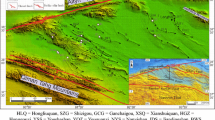Abstract
The north-striking Nanga Parbat–Haramosh Massif protrudes into the northwestern Himalaya along the axis of a great syntaxis1,2 (Fig. 1), where the Hindu Kush, Karakorum, and Himalayan ranges converge. As the Indus Suture Zone3 enters this region from the east it bifurcates into two branches, encircling what may be a docked island-arc terrane4. The southern branch (the Main Mantle Thrust) crops out on both flanks of the Nanga Parbat massif, forming a tight structural loop5. This massif and the adjacent terrane contain some of the highest peaks in the Himalaya; Nanga Parbat and the Indus River (located just 20km away) define the world's greatest continental relief (6,930 m). We report here the discovery of unexpectedly young sphene, zircon and apatite fission-track dates from the Nanga Parbat–Haramosh Massif. These dates (as low as 1.3 Myr for zircon and 0.4 Myr for apatite) imply that during the Pleistocene the Nanga Parbat region was uplifted and eroded at nearly 1 cm yr−1.
Similar content being viewed by others
References
Gansser, A. Geology of the Himalayas, 289 (Interscience, London, 1964).
Desio, A. Atti Conv. Lin. 12, 115–129 (1979).
Gansser, A. Tectonophysics 62, 37–52 (1980).
Tahirkheli, R. A. K., Mattauer, M., Proust, F. & Tapponnier, P. in Geodynamics of Pakistan (Geological Survey of Pakistan, Spec. Mem. 125–130, 1979).
Tahirkheli, R. A. K. Geol. Bull. Univ. Peshawar, Spec. Iss. 11, 113–130 (1979).
Wadia, D. N. Rec. geol. Surv. India 72, 212–234 (1932).
Misch, P. Am. J. Sci. 247, 209–246 (1949).
Naeser, C. W. in Lectures in Isotope Geology, 154–169 (Springer, New York, 1979).
Dodson, M. H. Contr. Miner. Petrol. 40, 259–274 (1973).
Naeser, C. W. Nucl. Track Detect. 5, 248–250 (1981).
Gleadow, A. J. & Duddy, I. R. Nucl. Track Detect. 5, 169–174 (1981).
Harrison, T. M., Armstrong, R. L., Naeser, C. W. & Harakal, J. E. Can. J. Earth Sci. 16, 400–410 (1979).
Wagner, G. W., Reimer, G. M. & Jäger, E. Mem. Inst. Geol. Miner. Univ. Padova 30, 1–27 (1977).
Kohn, B. & Eyal, M. Earth planet. Sci. lett. 52, 129–141 (1981).
Zimmerman, R. A., Reimer, G. M., Foland, K. A. & Faul, H. Earth planet. Sci. Lett. 28, 181–188 (1975).
Zeitler, P. K., Tahirkeli, R. A. K., Naeser, C. W. & Johnson, N. M. Earth planet. Sci. Lett. 57, 227–240 (1982).
Birch, F. Bull. geol. Soc. Am. 61, 567–630 (1950).
Menard, H. W. J. Geol. 69, 154–161.
Mehta, P. K. Tectonophysics 62, 205–217 (1980).
Narain, H. 6th Gen. Ass. Meet. I.U.G.C., Grenoble 1975).
Kai, K. Geochem. J. 15, 63–68 (1981).
Author information
Authors and Affiliations
Rights and permissions
About this article
Cite this article
Zeitler, P., Johnson, N., Naeser, C. et al. Fission-track evidence for Quaternary uplift of the Nanga Parbat region, Pakistan. Nature 298, 255–257 (1982). https://doi.org/10.1038/298255a0
Received:
Accepted:
Issue Date:
DOI: https://doi.org/10.1038/298255a0
- Springer Nature Limited
This article is cited by
-
Hydrothermal dolomitization in the Devonian Khyber Limestone Peshawar Basin, Pakistan: evidence from outcrop analogue, petrography, and geochemistry
Carbonates and Evaporites (2023)
-
The impact of glaciers on mountain erosion
Nature Reviews Earth & Environment (2021)
-
Knickpoints along the upper Indus River, Pakistan: an exploratory survey of geomorphic processes
Swiss Journal of Geosciences (2018)
-
An investigation on Balakot, Muzaffarabad (Pakistan) earthquake, 8 Oct. 2005, Mw 7.6; geological aspects and intensity distribution
Journal of Seismology (2009)
-
Response of grain size of Quaternary gravels to climate and tectonics in the northern Tibetan Plateau
Science in China Series D: Earth Sciences (2007)





